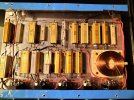Hi JohnH, and thanks for your reply.Hi @IvanMan , welcome to our thread.
The values are very carefully optimised to maintain tonal consistency at all settings and provide equal steps. I suggest 5% tolerance is OK. Maybe you could get some higher value and lower powered resistors to put in parallel with what you have to bring down the values?
Designing this needs close control of both input and output impedance at each setting, taking into account the amp and the speaker as a reactive load. Its too complex for a formula, I do it using a huge spreadsheet that plots every setting, and also SPICE models.
I guess you can wind the coil, if you can keep it tight and have a way to measure it afterwards. Personally I wouldn't trust formulas for inductance except as an approximation.
Good luck!
After some calculations I find series/parallel combination of the resistences I've already bought (used for my previous project) to match the requested values for 16 Ohm M2. My only concern is: using two (and in one case 3 resistor in parallel) may cause a change in tone / performance of the M2?
For the coil I find here in Italy a producer of HiFi component that have the 1.8mH / 18Awh(1mm) in catalogue for 10Euro. One problem solved

After your opinion I'll start with the realization.





